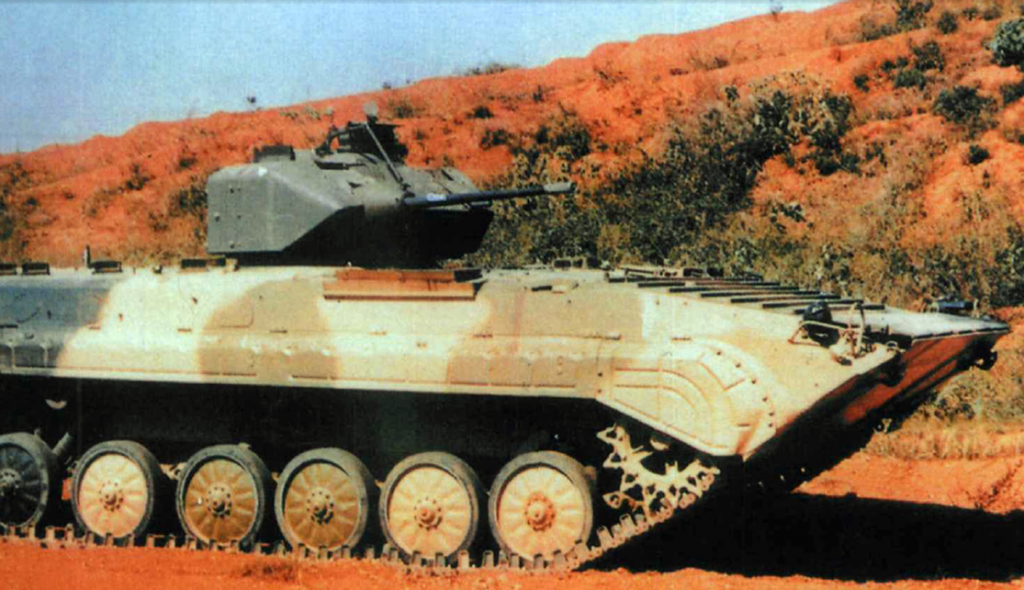
The NFV-1 was a joint Chinese-American project to combine the technologies of the two countries in order to create an advanced infantry fighting vehicle. Relations between the People’s Republic of China and the United States of America prior to the 1970’s was confrontational and hostile, with the former closely working with the Soviet Union. With the rise of Nikita Khruschev following Soviet Premier Joseph Stalin’s death in 1953, the People’s Republic of China and Soviet Union saw a dramatic change in relations due to ideological differences between Mao and Khruschev. Anti-Soviet sentiment in China reached its climax in the early 1970’s as a result of the Zhenbao Island Border Incident in March 1969, and the Cultural Revolution denounced Soviet revisionism. The growing hostility between these two Communist nations had provided the United States with an opportunity to potentially gain a new ally, seemingly in an effort to put pressure onto the Soviet Union. Nonetheless, American President Richard Nixon’s visit to China in 1972 marked the start of a new age of diplomacy between the two nations. Following Chairman Mao Zedong’s death in 1976, China had begun an economic reform under the leadership of Deng Xiaoping in an effort to mitigate the damages caused by the disastrous Cultural Revolution. One of the results of the economic reform was the opening of the Chinese market for foreign investors. Throughout the late 1970’s to the late 1980s, several private American companies had teamed up with Chinese firms for the purpose of initiating military projects. One of the said military projects from this period was the NFV-1, an Infantry Fighting Vehicle (IFV) design intended for the overseas arms market.
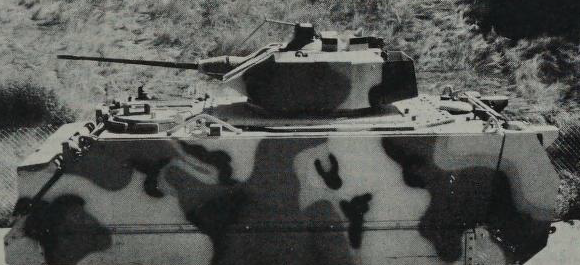
The Type 86 IFV was almost a direct copy of the Soviet BMP-1 IFV. Due to the Sino-Soviet Split which occurred in the early 1960s, the Soviet Union did not continue to provide China with their newest technology, like the Type 59 tank earlier in 1958. However, the Republic of Egypt had made several purchases of Soviet arms, which included the BMP-1. With the gradually improving relations between China and Egypt, Egypt provided NORINCO (China Ordnance Industries Group Corporation Limited) with a single example of the BMP-1 in the early 1980s, which was reverse-engineered and accepted into Chinese service in 1986 as the Type 86 (industrial designation WZ501). With the economic reforms set forth by Deng, China began to export their military equipment en-masse on the overseas market. Among the vehicles available were the Type 86, which the Chinese also developed variants for in order to increase the vehicle’s versatility. The Type 86 design was tested abroad in April of 1986, where it successfully completed a continuous 4,100 km / 2,547 mi course measuring its reliability and adaptability. Furthermore the Type 86 was also able to complete a 190 km / 118 mi mobility test in the desert, where it showcased its amphibious capabilities. Thus, the Type 86 had proven itself to be a capable IFV design just like the BMP-1. In the midst of this economic reform, along with improved relations with the United States, NORINCO was approached by the American Food Machinery Group (FMC) Corporation with a proposal for a joint development project for an IFV based on the Type 87. The proposal suggested the mating of a modified Type 86 chassis with a FMC one-man Electric Drive Turret (EDT) armed with the 25×137 mm / 0.98 in Hughes M242 Bushmaster auto-cannon and the 7.62×51 mm / 0.30 in FN M240 machine gun. The goal was to combine Chinese and Western technology into a low-cost yet effective modern IFV for customers in the international arms market.
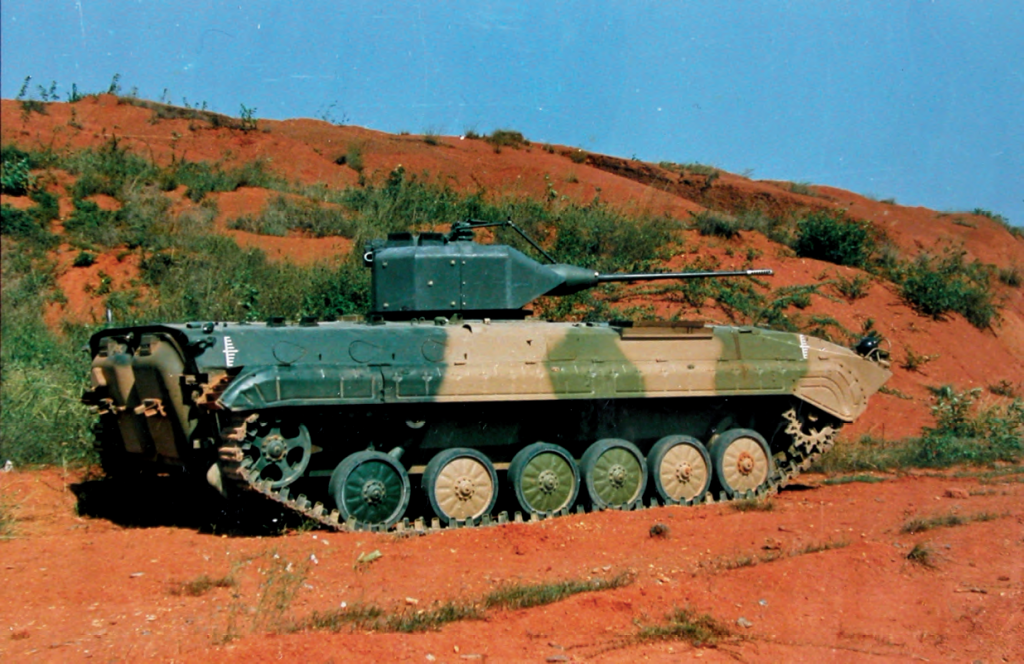
In March of 1986, NORINCO and FMC had formalized their partnership by signing a letter of intent for the joint development and production of the new IFV. This was followed by both sides signing a contract on June 19th to officialize the project. The primary objective was to provide an affordable yet competitive design for any customer in the international arms market while utilizing pre-existing components provided by both China and the United States. This project was given the designation of “NFV-1”, with the N signifying NORINCO, the F signifying FMC, and V signifying Vehicle. China had initiated several similar projects for combining indigenous and foreign technologies. Some examples include the well-known Jaguar Main Battle Tank, the NVH-1 IFV with Britain, and the NGV-1 IFV with France. The contract signed between NORINCO and FMC agreed that China would be responsible for producing the modified Type 86 chassis at Factory No. 627 while the turret and weaponry would be provided by FMC. Closely working together, the Chinese and American engineers were able to complete the design within three months, and produced a prototype by September. Preliminary examination of the prototype showed no flaws with the compatibility of the components, thereby not requiring any further modification or design revisions.
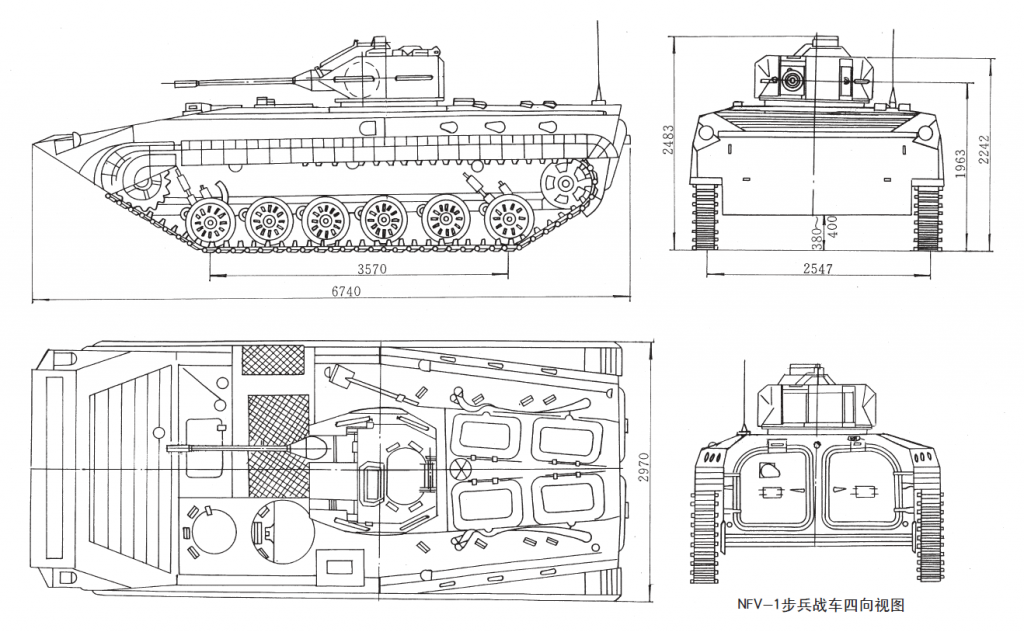
The NFV-1 chassis retained all the characteristics of the original Type 86 design, being able to carry eight fully-equipped troops (two machine gunners, one anti-tank gunner, and five assault troops) while retaining the original Chinese crew equipment (such as flare guns). The only difference was that there was an additional assault troop in lieu of an anti-air specialist which would usually be armed with a standard HN-5 (红缨-5) man-portable air-defense system (MANPAD). The chassis retained the standard Model 6V150 water-cooled diesel engine, providing 293 hp at 2,600 rpm. The torsion-bar suspension system along with the six road wheels also remained unchanged. The armor system featured special aluminum alloy plates capable of protecting the crew from small arms fire and shrapnel. In addition the chassis also provided nine firing ports for the troops carried as well as ten observation / sighting scopes to ensure optimal visibility and improved combat capabilities. The driver was provided an infrared observation scope while the commander was given a low-light observation scope capable of night and day operations.
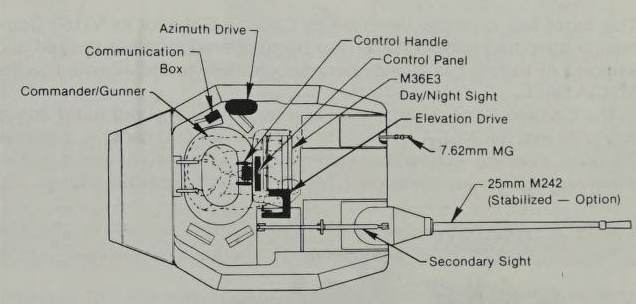
The only true and important change to the original Type 86 design was the replacement of the Soviet / Chinese 73 mm low-velocity cannon and its turret with an American-made FMC one-man Electric Drive Turret (EDT) housing a single 25×137 mm / 0.98 in Hughes M242 Bushmaster auto-cannon rounds and the 7.62×51 mm / 0.30 in FN M240 machine gun. The replacement of the turret also prevented use of the HJ-73 (红箭-73, Chinese production of the Soviet 9M14 Malyutka) anti-tank guided missile. The M2A2 Bushmaster auto-cannon was capable of firing rates from 25 rpm to 200 rpm and could be complimented by an optional two-plane stabilizer system. The EDT featured spaced laminate armor which gave it an equivalent thickness of 14.5 mm / 0.57 in of armor protection. Powered by a 24-volt electrical power supply, the turret also featured a manual drive system in case the power supply malfunctioned. The turret optics included the M36E3 sight for firing-control with both day and night capabilities, good for low-light conditions. Lastly, three M27 optics are provided for frontal and side viewing with provisional for an optional fourth one at the turret’s rear. The turret was able to traverse 360° electrically, and had a manual traverse rate of 60° per second. The auto-cannon had elevation angles of -7° to +47° via the electric system, also with a manual elevation rate at 60° per second. In total, the turret weighed about 1,409 kg / 3,106 lbs at its full combat weight (excluding gunner) and had a height of 1,864 mm / 73.38 in (minus turret slip ring).
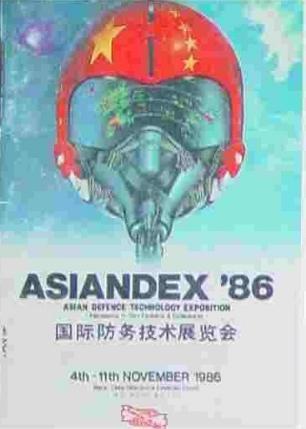
The NFV-1 was unveiled to the public for the first time in November at the 1986 Asian Defence Technology Exposition (known as ASIANDEX’86) held in Beijing, where the design was met with praise by the exposition’s attendees. Following the conclusion of ASIANDEX’86, the NFV-1 underwent extensive mobility, reliability, and firing tests in Xiangtan, Hunan (湘潭) and Beijing. Details of the tests are largely unknown, but Chinese sources suggest that some unspecified improvements were made to the NFV-1 by both Chinese and American designers. Following the conclusion of these tests, the NFV-1 was shipped to North Africa where it was exhibited once again to the international arms market at the November 1987 International Defence Exhibition held in Egypt. The NFV-1 design team was invited by Egyptian authorities, and the prototype underwent further mobility and firing testing in Egypt undertaken by the Egyptian Army. The status of the NFV-1’s development following these tests are largely unknown, and it cannot be confirmed how close the NFV-1 was to mass-production and exportation.
Cooperation between NORINCO and FMC was put to an immediate halt following the Tiananmen Square Incident of April 1989. Any further military exports to China were restricted, and all cooperation between Chinese and American defence firms were halted. The arms embargo and international condemnation of the incident had effectively strangled all Chinese military projects in development with the West, and NORINCO withdrew from the NFV-1 program soon after. The NFV-1 project was now solely run by FMC, and came to a standstill. The project was likely shelved or outright cancelled as FMC could not obtain the modified Type 86 chassis, and thus could not produce subsequent vehicles. According to the well-respected Jane’s Information Group, no new progress or production of the NFV-1 program has occurred by 2001. The fall of the Soviet Union in 1991 and subsequent flood of Soviet and Western equipment into the international arms market definitely would have made marketing for the NFV-1 difficult, as the former were being sold at low prices in bulk. The NFV-1 program can be considered all but cancelled at this point, having no known developments for nearly thirty years. However, the brief period of cooperation between the People’s Republic of China and the United States of America marked a temporary détente between Eastern and Western relations and saw mutual economic and military aid between countries once hostile to one another. The fate of the sole NFV-1 prototype is unknown, presumably having been scrapped at some point following the conclusion of the project.
Despite the NFV-1 project failing, the Chinese were able to closely examine and understand American technology. The lessons learned from the NFV-1 project proved invaluable for Chinese engineers and military experts. The original Type 86 design featured no fire-control system, and relied on manual aiming by the gunner which often proved inaccurate. Furthermore the high-velocity M2A2 Bushmaster auto-cannon was licensed to China, and the experience of designing the NFV-1 proved that such weapons were more effective than the original low-velocity 73 mm cannon in modern warfare. Chinese engineers began to indigenously improve the Type 86 design, resulting in the Type 86-I design. The Type 86-I housed an indigenously developed WA314T turret armed with a license produced M2A2 auto-cannon with a Type 59 tank machine gun. The Type 86-I was quickly placed into production in May of 1989 and received the industrial designation of WZ505, setting a precedent for all future Chinese IFV designs which emphasized auto-cannons.
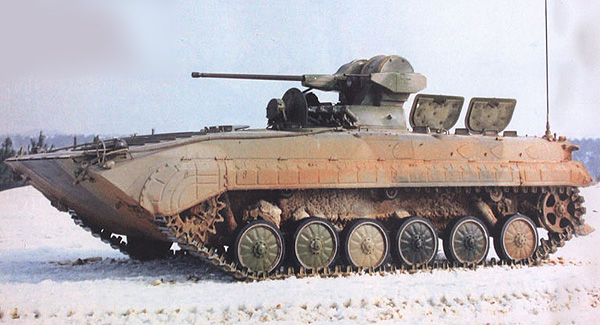
| NFV-1 Infantry Fighting Vehicle | |
| Length | 6.74 m / 22.11 ft |
| Width | 2.97 m / 9.74 ft |
| Height | 2.485 m / 8.152 ft |
| Powerplant | Model 6V150 water-cooled diesel engine (293 hp at 2,600 rpm, 15.9 kW per tonne) |
| Ground Pressure | 62.2 kPa |
| Top Speeds | 65 kmh / 40 mph on Land7 kmh / 4.34 mi in Water |
| Maximum Range | 460 to 510 km / 285 to 317 mi |
| Combat Weight | 13,600 kg / 29,982 lbs |
| Main Armament | 1x Hughes M2A2 Bushmaster auto-cannon (100 ready-use HEI-T rounds, 60 ready-use APDS-T rounds) |
| Secondary Armament | 1x FN M240 machine gun (5,000 rounds) |
| Crew | 1x Driver 1x Commander 1x Gunner |
| Troop Capacity | 8x Soldiers w/ Full Gear |
| Main Armament | 25 x 137 mm / 0.98 in Hughs M242 Bushmaster autocannon (165 rounds) |
| Secondary Armament | 7.62 x 51 mm / .308 in FN M240 machine gun (5,000 rounds) |

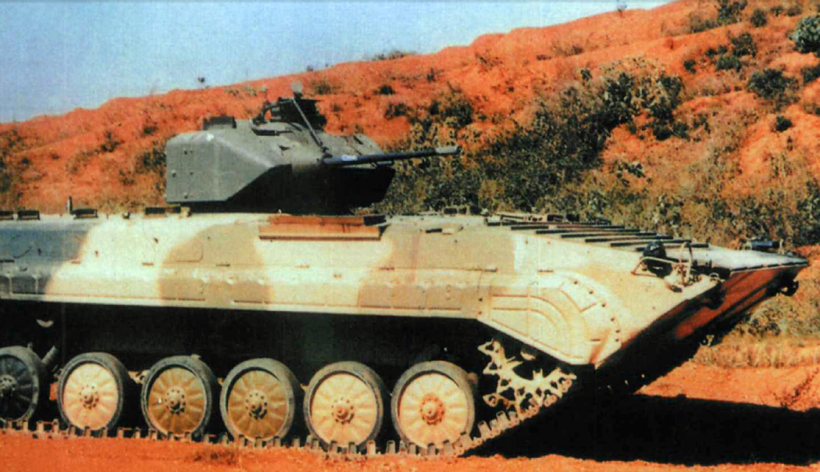
Where did you go…
It seems that the 25mm autocannon used on Type 86-I and WZ-551‘s WA314T turret is not a licensed bushmaster cannon. Instead, Chinese sources suggest that it’s something developed from a Chinese 25mm AA cannon, firing a much longer cartrige.